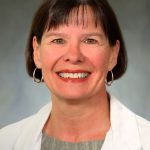
The poster hall at the ACR’s 2014 Annual Meeting in Boston seen from above. (Photo Keri Losavio)
Like solving sudoku, planning the ACR annual meeting requires an ability to recognize patterns and employ focused logical thinking, all the while remaining undaunted by the various paths possible to complete a grid from what looks like, at initial glance, an incomprehensible labyrinth of options.
The patterns in this situation are not numbers, but sessions, and the grid is the spreadsheet on which the meeting organizers arrange what sessions to offer when and where based on myriad considerations. Working out all the different potential ways the grid can be completed is the task the Annual Meeting Planning Committee (AMPC) grapples with each year to create a final program that meets the needs and interests of all members and attendees.
Meeting this demand is not easy. As the content of the meeting continues to grow on par with the growth in attendance, organizers are charged with creating a program agenda that offers a balanced representation of basic science and clinical research, education, clinical practice and other content.
One strategic way to accomplish this is by running concurrent sessions, a strategy that, like a good puzzle, requires creating a grid on which sessions are mapped to make the most logical and logistical sense—logical, in that organizers strive to assemble the content of the meeting in a way that minimizes offering sessions of like interest in the same time slots. Accomplishing this is not perfect science by any measure, but an aspiration nonetheless.
Organizers also must consider the logistical challenges of the meeting by ensuring, for example, that rooms assigned to sessions can accommodate the number of attendees expected to attend. Again, glitches happen, but the aspiration is high.
And in the pandemic era, considerations have included remote-learning platforms, creating opportunities for networking in a virtual environment and accommodating live questions of presenters across time zones, to mention just a few challenges.
It was not always so complex. In the beginning, the meeting drew 75 attendees and 11 scientific papers were presented. Today, the meeting attracts between 14,000 and 16,000 attendees, many of whom come from outside North America. And more than 4,000 abstracts are submitted, of which about 80% are accepted for presentation.
How did the meeting become what it is today? This brief history of the meeting captures some key changes made over the past eight-plus decades of the meeting’s existence from the people charged with leading the planning team, the AMPC chairs. Through their recollections, readers are offered a glimpse into the human effort behind what has become a reliably excellent educational venue for rheumatologists around the world.
In the Beginning
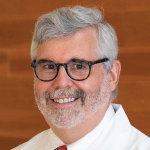
Dr. Jonathan Kay
In a chapter on the annual meeting published in a book published in conjunction with the 75th anniversary of the ACR, Jonathan Kay, MD, professor of medicine and population and quantitative health sciences and Timothy S. and Elaine L. Peterson Chair in Rheumatology at the University of Massachusetts Chan Medical School in Worcester, Mass., recounts the early years of the meeting and its evolution over time.1
The strong international presence underscores the importance of the meeting as arguably the premier meeting in rheumatology across the globe.
One striking change in the meeting is the steady increase in the number of attendees. In 1934, its inaugural year, the meeting had 75 attendees, as mentioned above. The numbers ticked up to 152 attendees in 1935, 260 in 1942, 1,325 in 1959, 1,644 in 1987 and so on, vaulting into the many thousands years later.
To give readers a sense of just how small the meeting was into the mid-1980s, Dr. Kay recalls attending his first meeting as a fellow in 1986. It was held in the ballroom of the Sheraton Hotel, Washington, D.C. The number of poster presentations was low enough that they could all be displayed in a hotel ballroom. Dr. Kay remembers feeling awed by the luminaries standing on the red carpet looking at the poster boards.
A year later, as a poster presenter himself, Dr. Kay recalls well that a giant within the field of rheumatology, Morris Ziff, MD, PhD, then chief of rheumatology at the University of Texas Southwestern Medical Center, Dallas, stopped by each poster to show his interest and offer brief comments to each presenter.
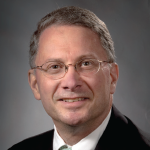
Dr. Furie
Such focused attention to all poster presentations today is nearly impossible given the huge expansion of posters presented. The posters have been moved from a hotel ballroom to a spacious convention center exhibit hall, competing for attention with industry vendors in the same size space.
Planning for the annual meeting begins almost immediately after the end of the prior’s year meeting, with a call for proposals occurring in October or November and planning in earnest beginning in January. Dr. Kay captures the feeling of a 1990’s-era planning meeting:
The meeting was held in a windowless room in an airport hotel in Atlanta. Committee members arrived on Friday evening and immediately set to work reviewing all the sessions proposed by members. Deliberations continued late into Friday night and resumed on Saturday morning, continuing throughout the day. Meals were served in an adjacent windowless hotel meeting room. On Sunday morning, miraculously, a meeting program was shaped and finalized by the collected committee members. When next seeing sunlight on Sunday afternoon, I felt like Florestan in Beethoven’s Fidelio emerging from darkness into the light of freedom. The tremendous accomplishment of the committee members evoked the celebratory music, in a major key, that accompanies Florestan’s return to the light of the world.1
Evoking the emotional heights of Beethoven’s sole operatic work to describe long hours of program planning suggests the humor needed to coax into reality a program that, until the early 2000s, was still created by sheer manual labor, unaided by computers.
When Dr. Kay served as the AMPC chair from 2001 to 2004, he made some changes to the committee to make the generation of a meeting program more efficient. Instead of all committee members meeting together as had been done, he appointed co-chairs to oversee selection of sessions representing two primary tracks at that time—clinical and basic science. Once each subcommittee selected their sessions, the entire planning committee would meet and engage in “a bit of horse trading” to determine what to include in the meeting.
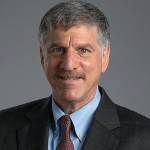
Dr. Block
Richard Furie, MD, chief of rheumatology at Northwell Health in Great Neck, N.Y., took over as AMPC chair in 2004 and served for three years. Seeing the difficulty of planning an ever-expanding meeting and the need for innovation, Dr. Furie convinced the ACR president at the time to add a pre-meeting planning meeting to help streamline the planning session in January.
In 1999, the meeting had grown to around 9,000 attendees, which was largely due to the approval of the first biologics for rheumatoid arthritis and the increased focus on clinical research generated by industry-sponsored trials. “The prediction was that the meeting attendance was going to grow even more in the ensuing years,” says Dr. Furie. “Therefore, accommodations for greater participation by researchers and clinicians was necessary.”
Under Dr. Furie’s leadership and through the leadership of subsequent chairs, Brian Mandell, MD, PhD, professor and chairman, Department of Academic Medicine, Rheumatology and Immunologic Disease at the Cleveland Clinic (2007 AMPC chair), and Joel Block, MD, the Willard L. Wood, MD, Professor and director of the Division of Rheumatology at Rush University, Chicago (2008–2011 AMPC chair), the meeting grew to include a number of innovations that remain to this day, among them: The Great Debate, Year in Review, Thieves Market, Curbside Consults, Knowledge Bowl, expanded workshop offerings, Poster Tours and an educator track.
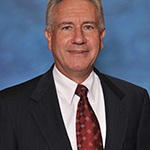
Dr. Oddis
“The three of us together over that period completely revolutionized the structure of the meeting,” says Dr. Block, emphasizing the credit due to Dr. Furie for spurring on the changes and pushing for updating the meeting.
According to Dr. Mandell, the shared philosophies among the three of them centered on the need to continually update the meeting by introducing something new each year. Part of the need to innovate was to accommodate the tension among the different constituencies of the College, he says, and to make the meeting maximally meaningful to clinical researchers, basic science researchers and clinicians. Content added for another constituency, educators, was emphasized during this period.
The ability to appeal to all these constituents is one reason the annual meeting is important, according to Dr. Mandell. “The annual meeting is a unique placeholder in rheumatology education,” he says.
Dawn of the Digital Age
One of the key changes Dr. Furie made during his tenure was to move the annual meeting into the digital age. “Rich [Furie] was very savvy with computers, and his major contribution was to use computerized spreadsheets, for example, to organize the meeting as opposed to using large pads of paper attached to easels [to map out the sessions] and posting these on the wall with masking tape,” explains Dr. Kay.
One basic change Dr. Furie made was to make a computerized record of the number of people who attended each session during the meeting to use for planning the next meeting. This was not done prior to his tenure and left the planning committee blind to, for example, what rooms to assign for particular sessions based on the number of expected attendees.
Using computer technology to help plan the meeting also facilitated organization of the multiple sessions the meeting now had to accommodate. “The volume had gone up three- or fourfold, so we needed more sessions that were hard to increase without having competition,” says Dr. Furie, who made the then unheard-of change to allow scientific sessions to run concurrent to the plenary sessions and poster presentations.
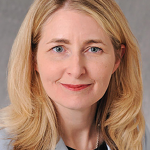
Dr. Shanmugam
Computers also helped with planning concurrent scientific sessions to permit participants to attend sessions that interested them. “There were efforts during our time frame to pay closer attention to what sessions were opposed to each other so we wouldn’t have content-related sessions in time slots opposed to each other that would place people in a dilemma to choose,” says Dr. Mandell, citing, for example, not scheduling lupus basic science talks during the same time slot as talks on clinical lupus or antiphospholipid syndrome, or having educator topics conflicting with clinical talks.
“During this time, the ACR also began to record and stream some sessions, providing initially a limited opportunity to watch some sessions from home after the meeting ended,” he adds.
Despite efforts to streamline the meeting for participants to attend sessions without too many competing interests, running concurrent sessions has not been ideal. “As the meeting grew and we started adding a lot of concurrent sessions, people have gotten annoyed because you can’t attend all the sessions and some interfere with the plenaries,” says Dr. Block. “Many thought the meeting had just gotten too big.”
Navigating a Growing Universe
To help attendees navigate a meeting that today attracts more than 16,000 participants, meeting organizers have implemented various tools. The on-demand tool provides those registered for the meeting free access to recordings of meeting sessions and offers a way for attendees to view sessions they can’t attend live. “Having concurrent sessions is good in terms of choice, but sometimes is frustrating if you want to be in two places at the same time,” says Richard Loeser Jr., MD, the Joseph P. Archie Jr. Eminent Professor of Medicine, Division of Rheumatology, Allergy, and Immunology, and director of the Thurston Arthritis Research Center at the University of North Carolina, Chapel Hill, who was AMPC chair from 2015 through 2017, noting that on demand alleviates some of that frustration.
Another tool was the ACR App that Chester Oddis, MD, professor of medicine and director of the Myositis Center, Division of Rheumatology and Clinical Immunology at the University of Pittsburgh School of Medicine, pushed for during his tenure as AMPC chair from 2012 through 2014. “It may have been more fully developed the year after I completed my time as AMPC chair, but this was a major change that made it convenient for attendees to use on their cell phone and tablet,” he says.
The availability of social media platforms also has pushed the meeting into ever easier ways for participants to access information and engage in sessions they both attend and can’t attend in person. Use of Twitter and chat rooms in real time during the meeting mean aspects can be accessed and navigated without necessarily being physically present. The move toward incorporating social media into the meeting was gradual, according to Dr. Block, who says it started when he was AMPC chair and has grown to become a prominent feature.
Now in its third year, the Twitter Ambassador program involves a group of individuals dedicated to posting on Twitter during the meeting. This helps inform those who aren’t able to attend the meeting or a given session of updates being presented. Twitter also serves as a platform for enriching discussion.
Greater reliance on computerized technology also paved the way for the ability of the meeting planners to pivot to an all-online meeting when the need arose. Social media and online platforms moved center stage in 2020.
Adapting to External Pressures
Over the years, the meeting planners have had to adapt to a number of external pressures, including after 9/11 in 2001 when the U.S. was on alert for further terrorist attacks. Dr. Kay, who was AMPC chair during that year, says, “We had organized plans to deal with any potential acts of terrorism and arranged communication by cell phone,” and cites just how on edge everyone was by a plane crash in Queens that occurred right at the beginning of the meeting that turned out not to be terrorist related.
That year was the only year attendance at the meeting was lower than the previous year, says Dr. Kay.
Prior to that, the meeting occurred every year with growing attendance except for the years from 1943–45 during World War II, during which the meeting was cancelled.
Undoubtedly the greatest external force on the annual meeting in contemporary times has been COVID-19. With an unknown virus rapidly spreading and countries worldwide rushing to adapt to growing restrictions on movement and in-person gatherings, the planning committee in 2020 made a quick pivot to developing a virtual meeting. Victoria Shanmugam, MD, director of The George Washington University Division of Rheumatology in Washington, D.C., and AMPC chair from 2017 to 2020, says the committee had already planned the 2020 meeting just prior to recognition of the gravity of the virus in February/March of 2020, but quickly made the massive paradigm shift to an all-virtual meeting to ensure the meeting went forward.
By all accounts the meeting was a success as evidenced by the positive feedback received and the level of attendance that again drew around 16,000 attendees from 111 countries. “This was an incredible feat for the College,” says Dr. Shanmugam.
Even before pivoting to a virtual format, the planning committee focused on making a number of changes in the 2020 meeting to better represent the demographics of the rheumatology community. “A goal we set in planning the 2020 meeting was to ensure gender equity in our speakers and presenters,” says Dr. Shanmugam. “It was something we built into every component of the planning for the 2020 meeting.”
Another benefit of the virtual format was that it allowed for more opportunities for engagement, she says, citing the ability for more participants in the question-and-answer session via the online poll function.
The virtual format has also expanded access to the meeting that tools like on demand and the meeting app had provided when the meeting was in-person only. For example, Dr. Shanmugam says the traditional meeting app has been replaced by the ACR Convergence site, where the meeting content is all in one place.
Continuance of the virtual meeting in 2021 attests to its success, but a common refrain heard is its big downside—the lack of in-person networking that many rheumatologists look forward to.
“The virtual meeting has its good and bad sides,” says Dr. Loeser, citing, for example, the two-minute summary offered by each poster presenter of their work as a positive to help decide which posters to visit virtually.
“The downside is that if you want to ask questions you use the chat box virtually, which is okay, but not the same as having a discussion in person at the poster,” he adds.
Dr. Loeser would like to see the recorded poster summaries continue going forward, but also have presenters standing at their posters for one-on-one discussions once the meeting moves back to an in-person gathering.
One big perk, according to Dr. Kay, is that the content of the virtual meeting is kept online several months after the meeting ends so attendees can freely view the presentations they missed. “That’s an innovation that provides members [and others] with the advantage of attending the meeting at their convenience and allows for viewing concurrent sessions without missing anything,” he says.
Like Dr. Loeser and all the other AMPC chairs who provided comments for this article, Dr. Kay misses the personal connection the in-person meeting offers. “Many friendships have been made and sustained through the in-person annual meeting,” he says, adding that direct communication with other attendees is lost through the virtual format. “I miss that very much and feel to some extent disconnected,” he says.
Still Evolving
As with any successful organization, the ACR’s annual meeting continues to evolve to meet the times. In 2019, the meeting was rebranded and now goes by the name ACR Convergence. The name reflects the global reach of the meeting that prior to COVID-19 drew about 60% of its attendees from outside North America. The strong international presence underscores the importance of the meeting as the premier meeting in rheumatology across the globe.
To remain the vital meeting it is, the planning committees over time have met the challenges of their day. Under the guidance of the AMPC chairs, the meeting continues to expand to address clinical and research issues pertinent to today’s practice of rheumatology. Describing the changes to the meeting over the years as occurring in “fits and starts,” Dr. Block is optimistic about the younger generation carrying the mantle forward.
“The whole time I was involved with the planning committee and then the educational committee, everyone was worried about engaging the younger generation and getting them involved in volunteer work,” he says. “I’m not convinced that there is a huge attitudinal change in people under 35 or 40 and see lots of members, young and old, getting involved.”
For Dr. Oddis, the last couple of years of virtual meetings may at least alter the way the younger generation participates in the meeting and the College at large. “I’ve always been concerned about the younger generation of rheumatologists; they are clearly different in many ways,” he says. Given the time commitments of traveling to and attending the annual meeting, he wonders if the younger generation will be less likely to commit to that given the value they place on personal time.
All-virtual meetings hold other challenges, he says, among which is funding that has relied heavily on the pharmaceutical industry. “If we no longer have a robust exhibit hall with strong interactions between pharma and ACR members, then funding may be drastically affected, so a future focus must be on funding as well as the innovative engagement of our members from an academic perspective,” he says.
What will not change is the continual hard work and institutional knowledge of the ACR planning committee staff, without which the meeting would not occur.
Mary Beth Nierengarten is a freelance medical journalist based in Minneapolis.
ACR Convergence 2022
ACR Convergence 2022, the world’s premier rheumatology experience, will be held Nov. 10–14 at the Pennsylvania Convention Center in Philadelphia. The meeting will be hosted in person, with opportunities to view content virtually and on demand. Learn more.
Reference
1. Kay J. Chapter 9: “The ACR annual scientific meeting.” In Pisetsky DS, ed. The ACR at 75: A diamond jubilee. John Wiley & Sons Inc. 2009.

